In this project, we are going to set up an ownCloud server on the Raspberry Pi. This server can act as your very own personal cloud storage.
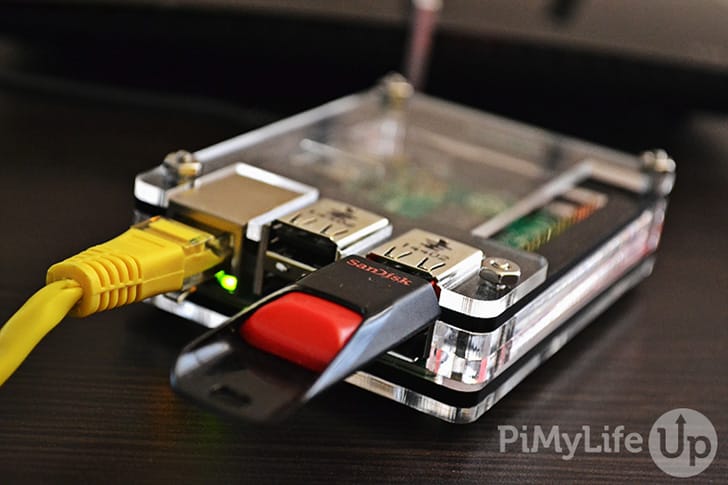
As protecting your privacy becomes harder and harder, you may be considering moving your files to a private self-hosted cloud storage. If this is the case, then this tutorial is perfect for you.
The ownCloud web interface is very similar to the many cloud storage providers that are available, such as Dropbox, Google Drive, and more. This similarity will make changing over to the self-hosted software much easier.
It is important to remember that since your data will be stored on your home network, you will end up with using more bandwidth if you upload and download files from outside your network.
This tutorial will take you through everything you need to know to get ownCloud setup and accessible.
If you are curious and want to learn more about the ownCloud software, be sure to check out the ownCloud website.
Equipment
I made use of the following equipment for this personal cloud storage setup.
Recommended
- Raspberry Pi Amazon
- Micro SD Card Amazon
- Ethernet Cable Amazon or Wi-Fi Amazon
- External Hard Drive Amazon or USB Drive Amazon
Optional
Note: It is highly likely that the USB ports on the Raspberry Pi will be unable to power an external hard drive so you may need to invest in a powered USB hub.
We last tested this tutorial on the Raspberry Pi 5 running Raspberry Pi OS Bookworm. We highly recommend that you update the to the latest operating system for the best experience.
Video
If you are a visual person and would like to see our video on how to put this tutorial together, check out the video below.
It will take you through everything you need to know get your Raspberry Pi ownCloud server up and running.
Setting up The Raspberry Pi ownCloud Server
Firstly, you will need to have a Raspberry Pi with an OS installed. If you haven’t installed Raspberry Pi OS, then check out our guide on installing Raspberry Pi OS. We recommend using the latest version for the best performance and reliability.
There are quite a few ways you can install ownCloud onto your Raspberry Pi. In this tutorial, we will be using Docker to set up ownCloud.
In our previous version of this tutorial, we used Nginx, but this method is deprecated, and we now recommend using Docker, especially since ownCloud still relies on PHP7.4.
Installing Docker
The first thing we need to do is install Docker on our Raspberry Pi. We will need this software to run the ownCloud software.
1. Firstly, in the terminal or via SSH, we will need to update the Raspberry Pi and its packages. Do this by entering the following two commands.
sudo apt update
sudo apt upgrade -yCopy2. You will need to ensure that you have Docker on your Raspberry Pi before proceeding to the next few steps. If you already have it installed, go to step 3.
If you need to install Docker, run through our tutorial on setting up Docker on the Raspberry Pi. It will take you through all the steps to set up the software correctly.
https://pimylifeup.com/raspberry-pi-docker/Creating the Required Directories
3. We now need to create the directories for where we will store the compose file and environment variables.
You can do this by running the mkdir command. The “-p” option will create any missing directories.
sudo mkdir -p /opt/stacks/owncloudCopy4. Now change into the newly created directory by using the cd command.
cd /opt/stacks/owncloudCopySetting up the Docker Compose File
5. Before we proceed, we will need to get the IP address of the Raspberry Pi. You will need to use the IP address in the environment file and to access the ownCloud web interface.
I recommend that you set your Raspberry Pi IP to static to avoid it changing in the future.
To get the IP address of the Raspberry Pi, enter the hostname command with the option “-I“.
hostname -ICopy6. It is time to write a compose file for our ownCloud setup. This file is a set of instructions Docker will run through to set up all the relevant services with the specified options. Alongside ownCloud, we will be setting up a MySQL and a Redis server.
Create and edit this file by running the following command. We will be using the nano text editor.
sudo nano compose.yamlCopy7. In this file, copy and paste the following text. Thankfully, we do not need to make any changes to this file, as any extra configurations will be stored in an environment file.
services:
owncloud:
image: owncloud/server:${OWNCLOUD_VERSION}
container_name: owncloud_server
restart: always
ports:
- ${HTTP_PORT}:8080
depends_on:
- mariadb
- redis
environment:
- OWNCLOUD_DOMAIN=${OWNCLOUD_DOMAIN}
- OWNCLOUD_TRUSTED_DOMAINS=${OWNCLOUD_TRUSTED_DOMAINS}
- OWNCLOUD_DB_TYPE=mysql
- OWNCLOUD_DB_NAME=owncloud
- OWNCLOUD_DB_USERNAME=owncloud
- OWNCLOUD_DB_PASSWORD=owncloud
- OWNCLOUD_DB_HOST=mariadb
- OWNCLOUD_ADMIN_USERNAME=${ADMIN_USERNAME}
- OWNCLOUD_ADMIN_PASSWORD=${ADMIN_PASSWORD}
- OWNCLOUD_MYSQL_UTF8MB4=true
- OWNCLOUD_REDIS_ENABLED=true
- OWNCLOUD_REDIS_HOST=redis
healthcheck:
test: ["CMD", "/usr/bin/healthcheck"]
interval: 30s
timeout: 10s
retries: 5
volumes:
- ${OWNCLOUD_FILES_LOCATION}:/mnt/data
mariadb:
image: mariadb:10.11 # minimum required ownCloud version is 10.9
container_name: owncloud_mariadb
restart: always
environment:
- MYSQL_ROOT_PASSWORD=owncloud
- MYSQL_USER=owncloud
- MYSQL_PASSWORD=owncloud
- MYSQL_DATABASE=owncloud
- MARIADB_AUTO_UPGRADE=1
command: ["--max-allowed-packet=128M", "--innodb-log-file-size=64M"]
healthcheck:
test: ["CMD", "mysqladmin", "ping", "-u", "root", "--password=owncloud"]
interval: 10s
timeout: 5s
retries: 5
volumes:
- ./mysql:/var/lib/mysql
redis:
image: redis:6
container_name: owncloud_redis
restart: always
command: ["--databases", "1"]
healthcheck:
test: ["CMD", "redis-cli", "ping"]
interval: 10s
timeout: 5s
retries: 5
volumes:
- ./redis:/dataCopyOnce you are done, save and exit by pressing CTRL + X, Y, and then ENTER.
8. It is time to write the environment file. This file will contain all the configurations we wish to set for the ownCloud software. For example, usernames, passwords, ports, and more. Docker automatically reads it and will match and replace the placeholders in the compose file with the relevant data from the environment file.
To create the environment file, enter the following command.
sudo nano .envCopy9. In this file, you will need to enter the following lines and replace each placeholder with the value you wish to use. We will explain each of these options below.
OWNCLOUD_VERSION=<VERSION>
OWNCLOUD_DOMAIN=<DOMAINORIP>:<HTTPPORT>
OWNCLOUD_TRUSTED_DOMAINS=<DOMAINORIP>
ADMIN_USERNAME=<ADMINUSERNAME>
ADMIN_PASSWORD=<ADMINPASSWORD>
HTTP_PORT=<HTTPPORT>
OWNCLOUD_FILES_LOCATION=<MOUNTPATH>Copy<VERSION>This placeholder represents the version of ownCloud you want to run on your Raspberry Pi. I recommend using thelatest, but you can always specify an older version such as10.<DOMAINORIP>Use this option to specify the allowed address for accessing the ownCloud instance. For example, if I want to use it locally, I will use the local IP, such as192.168.0.15.
If I want to access the software remotely, I can use an external IP address or domain name. You can add multiple domains and IPs by separating each of them with a comma. For example,192.168.0.15,test.pimylifeup.com. Please note, that multiple IPs and domains only applies to theOWNCLOUD_TRUSTED_DOMAINSvariable.<HTTPPORT>This is the default port that ownCloud will listen on. I recommend using a port such as8080or similar to avoid conflicts with other software.<ADMINUSERNAME>Replace this placeholder with the username you wish to use for your admin account. You will not be able to change this after the first setup.<ADMINPASSWORD>Like the username, the admin password is only used for the first setup. Afterward, you will need to change the password in the web interface.<MOUNTPATH>This is the path for storing the data of ownCloud. Using.datawill store it within/opt/stacks/ownclouddirectory. You can change this directory to wherever suits you the best.
You could set it to a mounted drive by using something like/mnt/usb1/owncloud. A mounted drive is a good option as it allows you to gain access to a lot of storage space.
OWNCLOUD_VERSION=latest
OWNCLOUD_DOMAIN=192.168.0.15:8080
OWNCLOUD_TRUSTED_DOMAINS=192.168.0.15
ADMIN_USERNAME=pimylifeup
ADMIN_PASSWORD=pimylifeup
HTTP_PORT=8080
OWNCLOUD_FILES_LOCATION=./dataCopyOnce you are done, save and exit the file by pressing CTRL + X, Y, and then ENTER.
Starting the ownCloud Server with Docker
10. To start your ownCloud server, all you need to do is run the following command.
Once initiated, Docker will download all the required software and start up each of the service with the specified options. Using the -d option will run Docker in the background.
docker compose up -dCopyFirst Start of ownCloud on the Raspberry Pi
I will briefly go through the basics of ownCloud running on the Raspberry Pi. If you want more information, I highly recommend checkout out the manuals on their website. You can find them at the ownCloud manual site here.
11. In your favorite web browser, you need to go to your Raspberry Pi’s IP address.
If you don’t know your IP address, you can run the hostname command on the Raspberry Pi.
hostname -ICopyBelow is an example of the address you will need to enter into the browser. Remember to update the IP address with the one you get from using the command above.
http://192.168.0.15:808012. You should now be greeted with a login page similar to the one below. Simply enter the username and password that we set in the environment file.

13. You will now see a page with a pop-up on how you can install the apps for desktop, Android, and iOS.
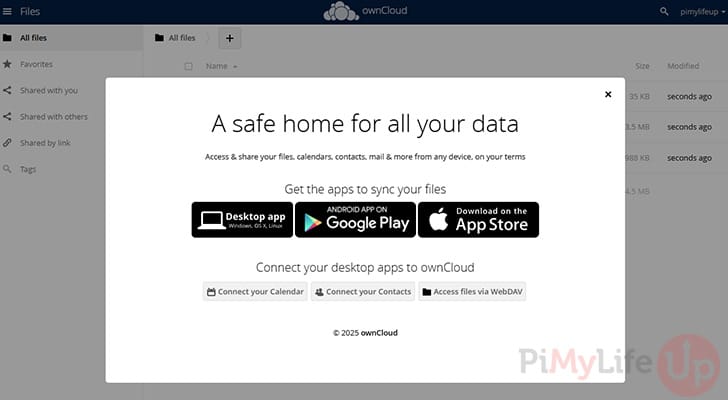
14. Lastly, test that you can upload files to your ownCloud installation by simply dragging and dropping a file into the web interface. It should upload without any issues.
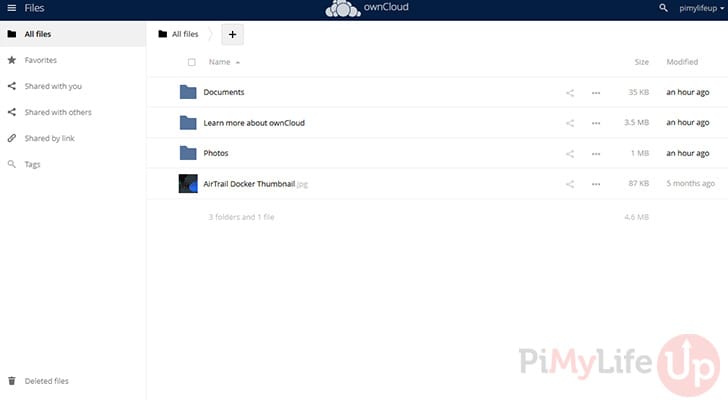
15. You now have ownCloud installed and running on your Raspberry Pi. The next couple of sections cover the basics for remote access, updating software, and backing it up to somewhere secure.
Setting up Remote Access
If you want to access the server remotely, I highly recommend using a service like Cloudflare Tunnels or Tailscale. These services are relatively easy for most people to understand and setup. Alternatively, setting up a reverse proxy like Traefik, or Nginx proxy manger will also work.
Once you have chosen your method of exposing ownCloud to the internet you will simply need to specify the IP address and port of the software. Most of the software above will generate certificate for your domain name.
Updating ownCloud Docker
Using Docker makes updating your ownCloud software super easy, and only involves a few simple steps.
1. Before you update, we recommend that you backup any data in case something goes wrong with the update. Follow our backup section for more information.
2. You will need to first change to the location of your ownCloud compose file. If you followed this tutorial, use the command below.
cd /opt/stacks/owncloudCopy3. You can simply tell Docker to pull the latest versions of the software specified in the compose file.
docker compose pullCopy4. Once the latest software has been downloaded, you must issue the compose up command. This command ensures that the software running in docker is updated to the latest versions we downloaded earlier.
docker compose up -dCopyBacking up ownCloud Docker
Backing up your data is highly important as data drive failure, natural disasters, corruption, or accidental deletion can happen at any time and when you least expect it. Luckily, backing up data is relatively straightforward.
I recommend you can use rclone on the Raspberry Pi or something similar to copy and store the data in another location. You can also automate the following steps using a bash script and setting up cron.
1. You will need to first change into the location of the compose file.
cd /opt/stacks/owncloudCopy2. First, stop the docker container by running the following command
docker compose stopCopy3. The next couple of lines require you to have rclone installed, but they will simply sync the contents from the source location to the destination. For example, /opt/stacks/owncloud/data will sync to /backups/owncloud/data.
You can also setup rclone to sync to a remote location rather than local. This method is highly recommended for backing up important data.
sudo rclone sync /opt/stacks/owncloud/data /backups/owncloud/data --progress
sudo rclone sync /opt/stacks/owncloud/mysql /backups/owncloud/mysql --progressCopy4. Once the above two commands are finished, start the docker container by running the following command.
docker compose up -dCopyAs I mentioned earlier, you can add the above commands into a bash script that you can then automate the backup sequence. I highly recommend that you schedule the backup to occur when the server is least likely to be in use.
Conclusion
I hope this tutorial has helped you set up your very own Raspberry Pi ownCloud. You should now be able to upload and store files within your own personal cloud.
If you are interested in other self-hosted projects, I also recommend taking a look at Immich on the Raspberry Pi. It is a great software for storing and viewing photos.
If you have any troubles, want to leave feedback or if I have missed anything feel free to drop us a comment below.
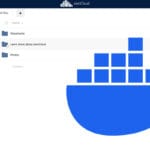

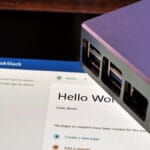
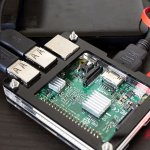



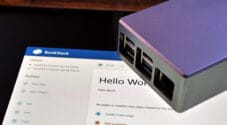
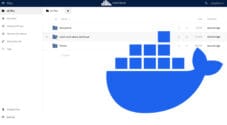
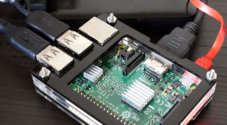
Great tutorial! I have everything working nearly perfectly. I have set up a dynamic DNS and it works perfectly when I’m off my home network and if I type in the IP when I’m connected to my home network it works perfectly as well. If I try to connect to the server from my home network by putting my DNS into my browser it just takes me to my router. How do I access the server with the same address regardless of what network I’m connected to? I want to be able to connect from my iPhone whether I’m at home or away without logging out and reconnecting. Thank you!
I don’t know if I did something wrong, but when I type my ip address in my browser, it gives me an error 502 Bad Gateway
i can login to my owncloud but i cant use the app. when i login to owncloud it says there was a problem with code integrity.
php does not seem to be setup properly to query system environment variables. The test with getenv(“PATH”) only returns an empty response.
The “Strict-Transport-Security” HTTP header is not configured to at least “15552000” seconds.
– INVALID_HASH
– .htaccess
– .user.ini
any help please thank you. i followed the guide exact and have completely started over 4 times and get the same error
Thanks for this well-explained and easy-to-follow tutorial Gus,
I literally only had to adjust the owncloud version (9.1.3 at the time of writing).
I’d add a warning when people make changes to the core files of owncloud, such as .htaccess and .user.ini, as this will generate an annoying warning banner if you log on as the administrator. Nothing to worry about and only the admin gets it.
I also added
add_header Strict-Transport-Security “max-age=15552000; includeSubDomains”;
in the default config file, as indicated by another warning and explained in the owncloud documentation.
Thanks Björn, Made a note in the tutorial about the alert!
Brilliant ! Everything works perfectly, thank You for Your time.
You made my day :3
Can I acces it everywhere (out of my network)?
How to make it to work with non password, but somebody who haven’t got password, only can download the files, but can’t upload or edit the files
I copy and pasted every code and followed the directions very closely but I can’t open up the own cloud admin page. Please help.
When i try to access it externally i set up everything as show (i have a static external ip so it made it easier) but when i try to access using
https://xxx.xxx.xxx.xxx:xx(my address and port forwarding i used) i still get a secure connection error.i have been having issues with permissions as stated in my previous comment and i was just wondering is there a config file somewhere in the downloaded owncloud files that can be edited to change the user and group owncloud requires that the data directory be owned by. so basically a way to simply change www-data to pi so that the permissions issue isn’t a problem. if that makes sense lol. any help would be greatly appreciated.
i m having the same issues with permissions while mounting the hdd and the only thing i can think of being the issue is that the hdd is being mounted with the group and user id for www-data and not the pi user www-data gid and uid is 33 and pi is 1000. now im not an expert with linux but if there was a way to either add pi to the www-data group or to change the gid and uid of the pi user so it matches www-data that may fix the issue. im thinking the reason why some are having this issue and others arent is the difference in the pi models. just the same and android phones the systems usually have small (or large) differences that can throw things out of wack for some users and not for others. if anyone knows how to fix this issue help would be greatly appreciated. fstab must match the www-data gid and uid for owncloud to work properly im assuming so just changing the gid and uid to pi’s i doubt will work. thanks in advance for any help.
Hi, when I try to install the OwnCloud server files, my pi says it has not enough storage. I am using a 16 GB SD card. Does anybody know what I should do?
Check to see if you have expanded the filesystem to take up the entire SD card, this can be found by using the raspi-config command and then selecting Expand-Filesystem. Alternatively in the GUI go to the main menu->Preferences->Raspberry Pi Configuration
Hi team,
After installation owncloud showed me this message
“No memory cache has been configured. To enhance your performance please configure a memcache if available. Further information can be found in our documentation.”
What to do ?!
Thank you very much
When i go to my IP address to finalize the set up, i put the /media/ownclouddrive into the box, and press finish, but it then pops up with an error “can’t create or write into the data directory /media/ownclouddrive. i tried to figure out the error made in fstab, but i dont see any error. i deleted the added line, and still nothing.
Hello everything worked in the beginning but when I try to access the pi from his local ip ( I always did that) it gives the error 192.168.1.104 can not process this request.HTTP ERROR 500…
Help please
greetings,
Jesse
after finishing the setup for owncloud i revised this message
"php does not seem to be setup properly to query system environment variables. The test with getenv("PATH") only returns an empty response.Please check the installation documentation ↗ for php configuration notes and the php configuration of your server, especially when using php-fpm."
"Some files have not passed the integrity check. Further information on how to resolve this issue can be found in our documentation. (List of invalid files… / Rescan…)"
how do i fix this
Hello,
I haven’t had any of the problems that the others are having. in fact, my server was up and running in about 15 minutes, and fully functional. however, when i log in to the cloud, the admin account has a warning banner. one of the set up and security settings warnings says
“php does not seem to be setup properly to query system environment variables. The test with getenv(“PATH”) only returns an empty response.
Please check the installation documentation ↗ for php configuration notes and the php configuration of your server, especially when using php-fpm. ”
how do i resolve this? i don’t want to edit php config files and end up messing everything up.
the next warning refers to the integrity check:
“Some files have not passed the integrity check. Further information on how to resolve this issue can be found in our documentation. (List of invalid files… / Rescan…)
lastly, is in reference to strict transport security:
The “Strict-Transport-Security” HTTP header is not configured to at least “15552000” seconds. For enhanced security we recommend enabling HSTS as described in our security tips.
How do i rectify this?
info on server:
Raspberry Pi 3
Raspbian-Jessie with pixel
Your help is greatly appreciated!!
Hi Gus.
I have sucessfully set my Owncloud and am getting these 2 warnings:
-The “Strict-Transport-Security” HTTP header is not configured to at least “15552000” seconds. For enhanced security we recommend enabling HSTS as described in our security tips.
-No memory cache has been configured. To enhance your performance please configure a memcache if available. Further information can be found in our documentation.
Is there anything that should be done or should I disregard these?
I am stuck with creating a key and get the following error
writing new private key to ‘/etc/nginx/cert.key’
/etc/nginx/cert.key: No such file or directory
1995593824:error:02001002:system library:fopen:No such file or directory:bss_file.c:398:fopen(‘/etc/nginx/cert.key’,’w’)
1995593824:error:20074002:BIO routines:FILE_CTRL:system lib:bss_file.c:400:
Hello, I am new to the project and I would like to ask about the “Ethernet Cord or Wifi dongle” part.
Im using Raspberry Pi 3 B.
So, do I need to get a wifi modem to connect to this raspberry pi in order for people to connect to the cloud?
Or people able to connect to the cloud with just a wifi dongle?
Hanson,
Your RPI3 already has a wifi adapter built in. no need for a dongle to get you Pi on the network. ultimately, ethernet is best because it’s faster. but if you can’t do that, then just use your built in adapter. that’s what i’m doing.
Hi
Can I transfer image or voice using a raspberry pi to the cloud server ?